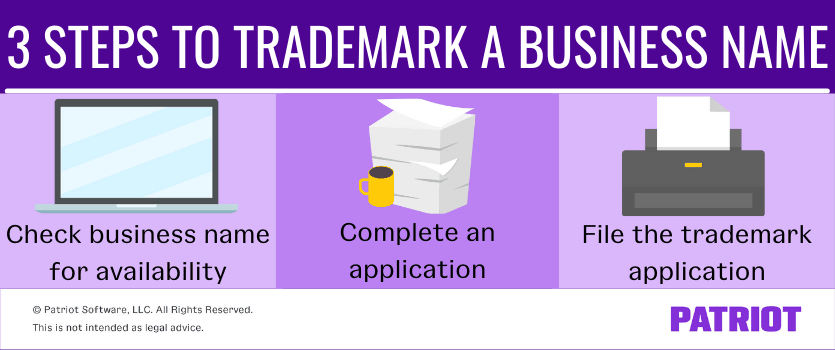Naming your business is one of the most fun and crucial parts of opening it. You take the time to research if it’s available, ask others for their opinions, and register it with the state to legally stake your claim to it. But, is that enough? It might be a good idea to trademark your business name, just in case. Learn how to trademark a business name to protect your company from the get-go.
3 Steps on how to trademark a name for a business
There are a few steps included in how to trademark a business name. So, how do you trademark a name? The three steps to follow are:
- Search your business’s name to check for availability
- Complete an application for a trademark
- File the trademark application

If you decide to copyright your company’s name, you must follow all three steps. You can only use a specific trademark, copyright, or registered trademark symbol if you have an approved application.
1. Search your business’s name
When you first started your business, you selected a name. That name could be your actual name or a doing business as (DBA) name (aka a trade name). Then, you registered your business name with the state.
You checked to see if your company’s name was available to register with the state. If the first name wasn’t available, you worked until you had a name that was available and fit your business.
Now, it’s time to search again. Businesses across the country may have the same or similar names. Why? Because a name that’s available in one state may be used by a business in another state (which could be a not-so-fun surprise if you have an online store). To apply for and receive a trademark for your business’s name, it must not already be registered by another business in the entire country.
When trademarking your company’s name, search for your specific name and similar names. Why? The US Patent and Trademark Office (USPTO) may deny applications for a trademark if a name is too similar to an existing trademark. For example, Yankee Doodle’s Nursery and Yankee Doodle Nursery might be too similar to receive a trademark.
How do you search for trademarked names? Use the Trademark Electronic Search System (TESS). The system allows users to search the database in five ways (e.g., word only or word and design).
2. Complete an application for a trademark
Do you plan to trademark a name you currently use or a name you plan to use in the future? The USPTO allows users to apply for a trademark in either case. And, users can choose to submit one of two electronic forms:
- TEAS Plus
- TEAS Standard
All applicants must submit their selected form through the Trademark Electronic Application System (TEAS).
TEAS Plus applications have more up-front requirements but a lower fee per class of goods and services. The TEAS Standard application has fewer up-front requirements but a higher cost per class of goods and services. And, all TEAS Standard applicants must eventually meet all application requirements.
Regardless of the selected application, the application includes 10 sections to complete:
- Applicant’s name and address
- Citizenship state and legal entity of the applicant
- Designated name and address of contact individual (does not have to be the applicant’s information)
- Name for the trademark or drawing of the mark to be trademarked
- Description of the mark, if applying for one
- A list of specific goods or services the trademark application covers
- Class of goods or services
- Date the mark was first in use and an example of it in use
- Signature of the applicant or representative with the date
- Fee for the appropriate application and number of classes included
Provide all necessary information for your specific trademark. The USPTO does not offer assistance with completing the application. Consult a business lawyer or an attorney specializing in trademark registration with any questions.
3, File the trademark application
Again, you have two options for filing a trademark. The TEAS Plus option is less expensive and offers a streamlined experience. There is a preset list of goods and services in the Plus option. And, there is a lower rejection rate.
The TEAS Standard application is more expensive and time-consuming. But, businesses providing goods or services that do not fall under the preset list of TEAS Plus may benefit from using the Standard application process.
After filing the trademark application
Submitted your trademark application? Great! Now, it’s time to wait. The USPTO will examine the application and give your application a serial number. And, the trademark office assigns a trademark examining attorney to your application.
The examining attorney reviews the application to ensure it meets all legal requirements and can be registered. During the review, the USPTO searches currently registered and pending trademark applications to evaluate if there are any conflicts. Additional research informs the USPTO if the trademark applies to the selected industry, reviews the specific goods or services listed, and ensures compliance with the filing requirements.
The entire trademark process takes between 12 and 18 months from start to finish. There is no guarantee that the trademark office will approve the application. Applicants can check their status using the Trademark Status and Document Retrieval (TSDR) system.
FAQs for trademarked names
When considering trademarking your business name, you may have some questions. Here are a few frequently asked questions.
1. What are the benefits of trademarking a business name?
There are several reasons why trademarking your business name can benefit you. Some benefits include:
- Presumed ownership of the business name in the United States
- Exclusive rights to using any associated symbols, logos, slogans, or images for the goods or services listed in the registrations
- Ability to pursue legal matters regarding trademark infringement in federal court rather than through state courts
- Protection of your brand name through cyber means, including URL domain names, under the Anticybersquatting Consumer Protection Act
- Right to request assistance from the United States Customs and Border Protection Agency in cases where imported goods use your exact or a substantially similar trademark
2. Is there a difference between a trademark, a service mark, and a trade name?
Trademarks and service marks are terms used interchangeably. But, there is a difference. A trademark protects the goods sold, while a service mark protects services.
The trade name is simply the name used in place of the actual business’s name (aka the DBA). Many companies use trade names when the official legal name is too long or their original name is too close to another name.
3. Should businesses trademark their company names?
There are no legal requirements stating that businesses must trademark their names. But if you engage in substantial interstate or international commerce, the benefits of a trademark can protect your brand identity and intellectual property. State registration does not afford the same protections as a federal trademark.
4. How much does the trademark application cost?
How much to trademark a name depends on the application. There are two applications for trademark registration, and costs differ between applications. So, how much does it cost to trademark a business name?
TEAS Plus application cost: The cost to apply using the TEAS Plus option is $250 per class of goods or services on the application. For example, a business with two classes of goods would pay $500 ($250 X 2).
TEAS Standard application cost: The cost to apply using the TEAS Standard option is $350 per class of goods or services on the application. A business with two classes of goods would pay $700 ($350 X 2).
5. Does my trademark registration last forever?
Trademark registration does not last forever. However, businesses may keep their trademark active by following the required steps:
- Continue using the trademark in commerce
- File all required maintenance forms and documents timely
- Promptly delete any goods or services from the registration if no longer in use
- Pay all fees
Failure to comply with the requirements will cause the USPTO to invalidate the trademark.
This is not intended as legal advice; for more information, please click here.



